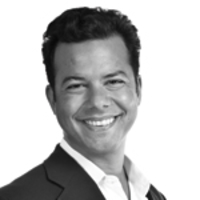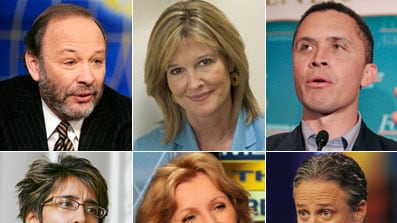Professional partisans present a vision of American politics where everything is divided between the far left and the far right. Lately, they seem to be dominating the nation’s political debate.
But there's a powerful backlash brewing—a movement of voices from the vital center who are declaring their independence from play-to-the-base politics.
Just as independent voters are now the largest and fastest-growing segment of the electorate— 42 percent, according to the most recent CBS/New York Times poll—an increasing number of centrist columnists and commentators are rejecting the ideological straitjacket and extremists on both sides.
The nation’s most widely syndicated columnist, Kathleen Parker, recently declared her independence in a column that said “it’s time to denounce the harsh partisans who feed on polarization. It’s time to give independents a voice.”
Parker followed in the steps of radio host Michael Smerconish, who wrote a February column for the Philadelphia Inquirer on his decision to register independent after 30 years in the GOP. In December 2009, Andrew Sullivan eloquently announced his official break from the right— his column echoed the author of the LittleGreenFootballs blog, Charles Johnson, who had risen to prominence as a committed anti-jihadist— a cause he still continues to fight. “I used to get some pretty nasty hate mail from radical Islamists,” he told me, “but the stuff I’m getting right now from right wingers is an order of magnitude worse.” At the same time, centrist Democrats find themselves embattled and attacked by an emboldened liberal netroots culture.
These voices have been coming to the same conclusions individually—that the parties are too controlled by their most strident, uncivil, and extreme elements. Like most voters in the vital center, there is a coherence to their beliefs—a consistent advocacy of fiscal responsibility and individual freedom which leads most to be closer to the GOP on economic issues and closer to the Democrats on social issues.
Some might call themselves libertarians, others radical centrists, moderates or independents—but the underlying ideas are the same. They have refused to surrender their conscience or common sense to walk in lockstep with one political party. Theirs is a rebellion from the pressures to conform in today’s hyperpartisan debates.
In March, The Daily Beast’s Tunku Varadarajan developed lists of the most prominent journalists from the right and left. His lists enumerated the rise of ideological advocacy journalism in print and online, including television and radio-show hosts who often function as the two parties’ attack-dogs and apologists. These divisions are often encouraged by newspapers and networks in an attempt to appeal to narrow but intense niche audiences.
This list is intended to fill out the full spectrum of political debate, spanning the center-right and the center-left. It was developed with certain criteria in mind: the individual’s civility or sense of humor when engaging in political debates; their pragmatic approach to problem-solving; their principled independence from partisanship and willingness to criticize the extremes on both sides of the aisle; and finally, their prominence in the arena.
Those invested in the right/left, red state/blue state divide of American politics do their best to deny the existence of the center in American politics while simultaneously launching party purity purges. Individuals on the center-right are cast out and called “squishes” by conservatives who are turning their political faith into something resembling a cult. Likewise, on the left, centrists are increasingly attacked as "corporatists” because of their commitment to fiscal responsibility and belief that thriving private industry is the backbone of the American economy. These ideas are enforced by a relatively small number of self-appointed sentinels in defense of a declining orthodoxy—a Pew poll from last year found that only 15 percent of Americans call themselves conservative Republicans while just 11 percent describe themselves as liberal Democrats.
In fact, the center does not only have the numbers, it has intellectual coherence and strong advocates. There are academics like the Hoover Institution’s Morris Fiorina, author of Culture War? The Myth of a Polarized America and McGill’s Gil Troy, author of Leading From the Center. There are centrist think tanks, like Will Marshall’s Progressive Policy Institute and The Third Way associated with the Democratic side of the aisle and the Main Street Partnership for the GOP. There are centrist radio-show hosts like Michael Smerconish, Ronn Owens, and Alan Nathan. There are centrist Web sites like TheModerateVoice.com, Donklephant.com and BookerRising.net—as well as aggregators like Fark.com that skewer absurdities on both sides. Most important are the grassroots groups that are growing up on their own, like the Village Square movement based out of Florida, the Transpartisan Alliance, or the newly formed Pragmatic Center, which announced its presence in the wake of Kathleen Parker’s column.
The purpose of this list is to show that there is a coherent and strong centrist movement growing in America right now. It is principled and civil. It is independent of the two parties’ influential, entrenched special interests. And it is on the rise.
Taken together, this list should be a reminder that American politics was not always seen as a high-pitched battle between the far left and the far right. A century ago, a more reasoned analysis divided American politics into three currents: radicals, reactionaries, and progressives. Radicals wanted radical change. Reactionaries wanted no change. Turn-of-the-century progressives like Teddy Roosevelt wanted moderate change—reform, not revolution. They are the centrists of today—people who want America to move not left or right, but forward.
Take a look at the list and let the debate begin…
John Avlon's new book Wingnuts: How the Lunatic Fringe is Hijacking America is available now by Beast Books both on the Web and in paperback. He is also the author of Independent Nation: How Centrists Can Change American Politics. Previously, he served as chief speechwriter for New York City Mayor Rudy Giuliani and was a columnist and associate editor for The New York Sun.





